
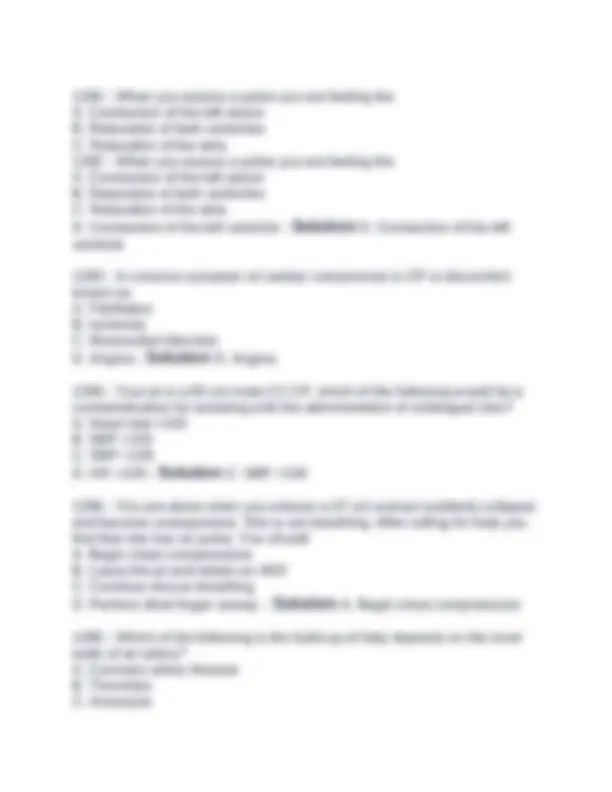
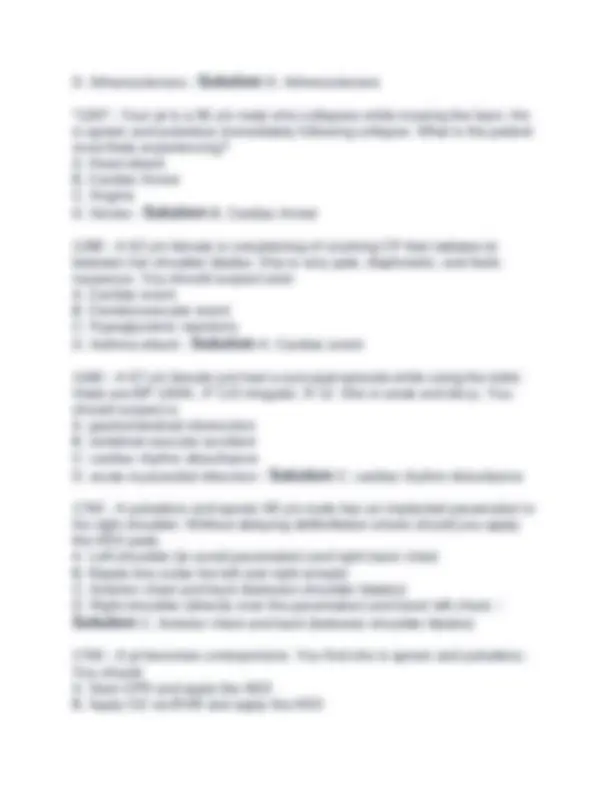
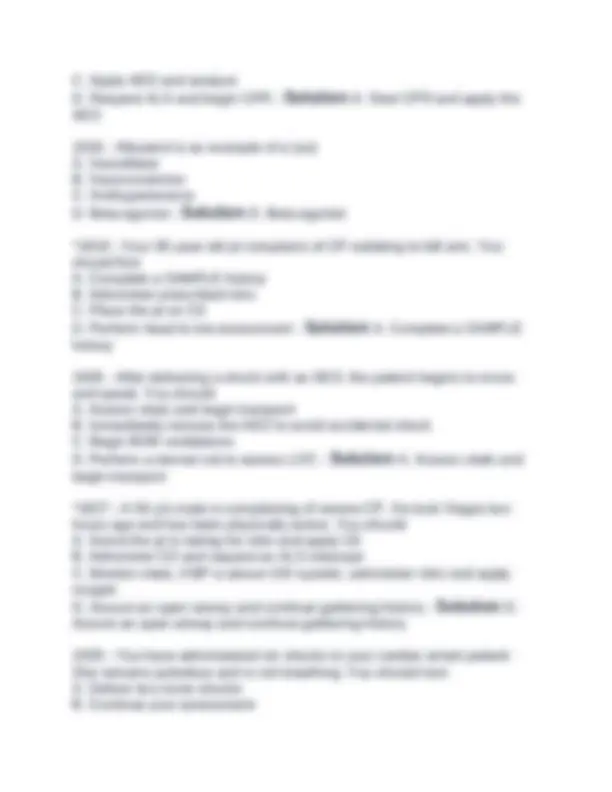
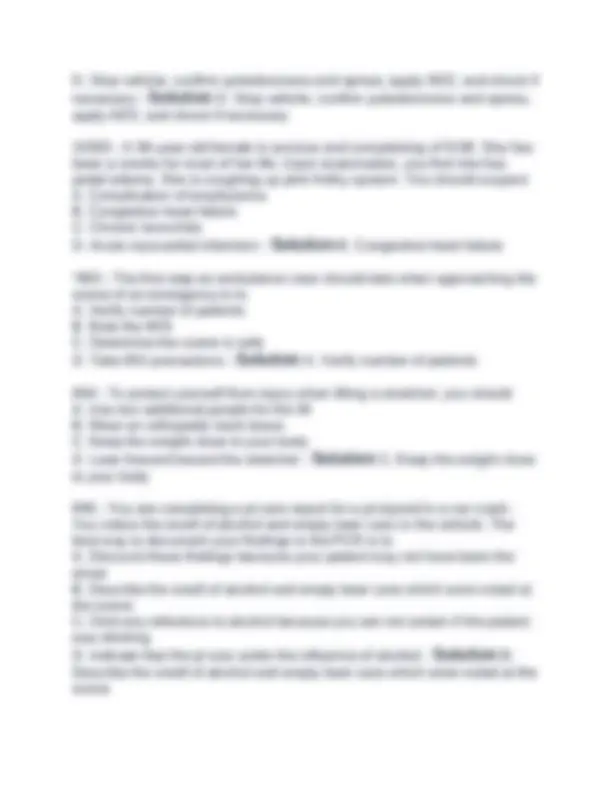
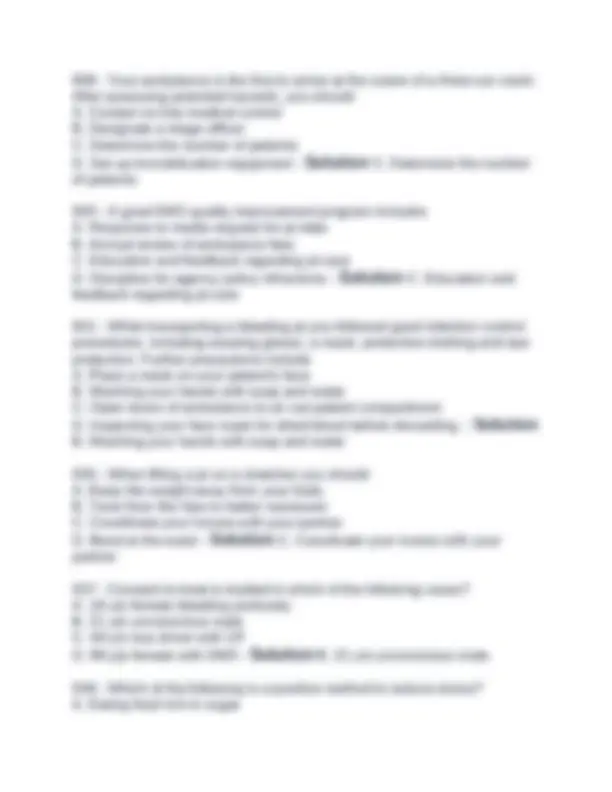
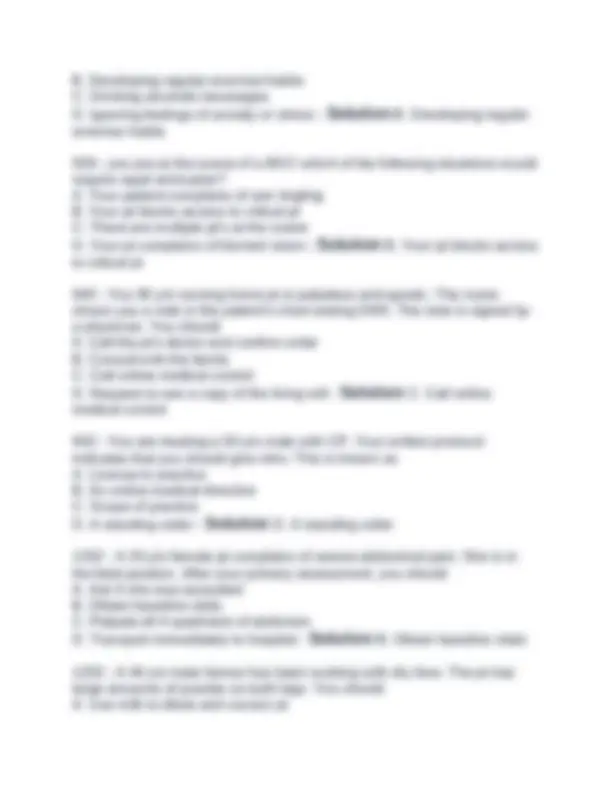
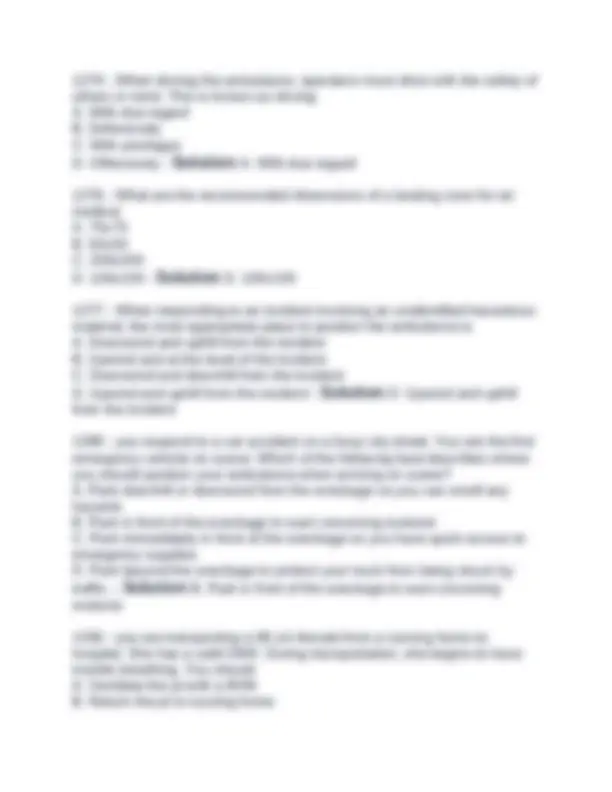
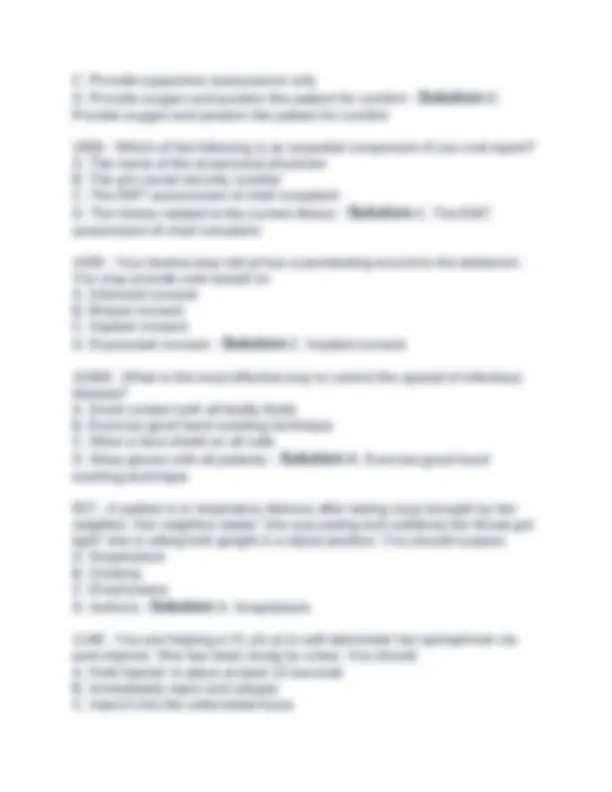
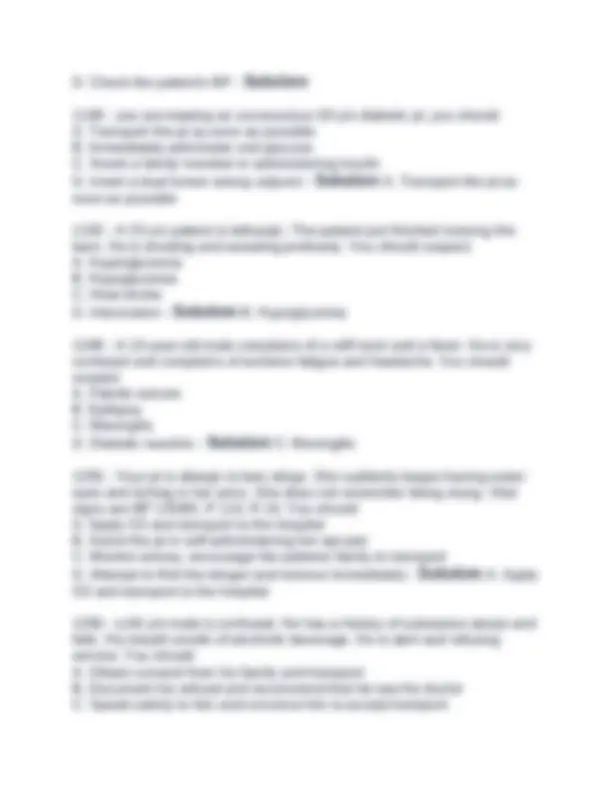
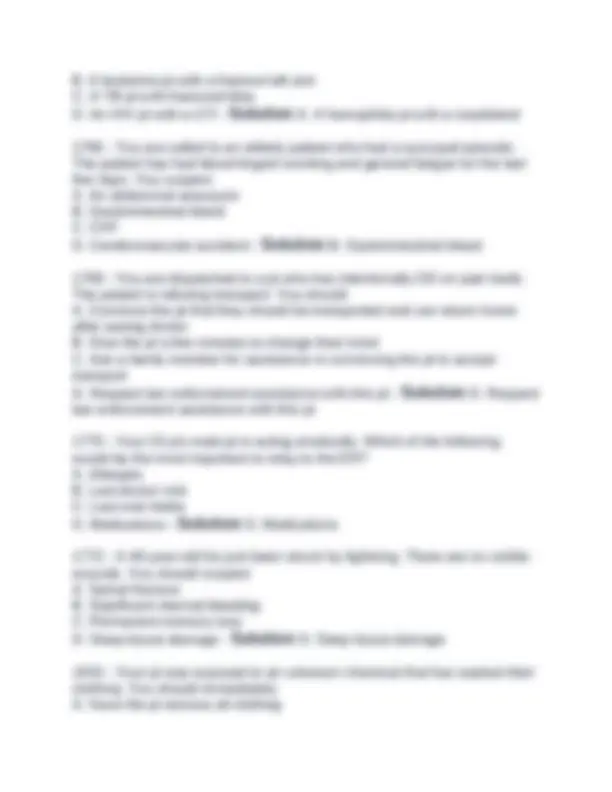
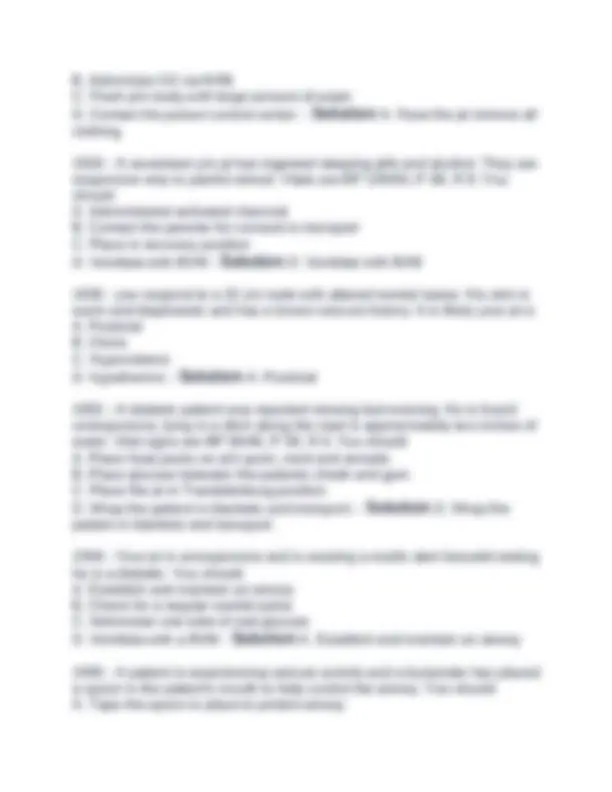
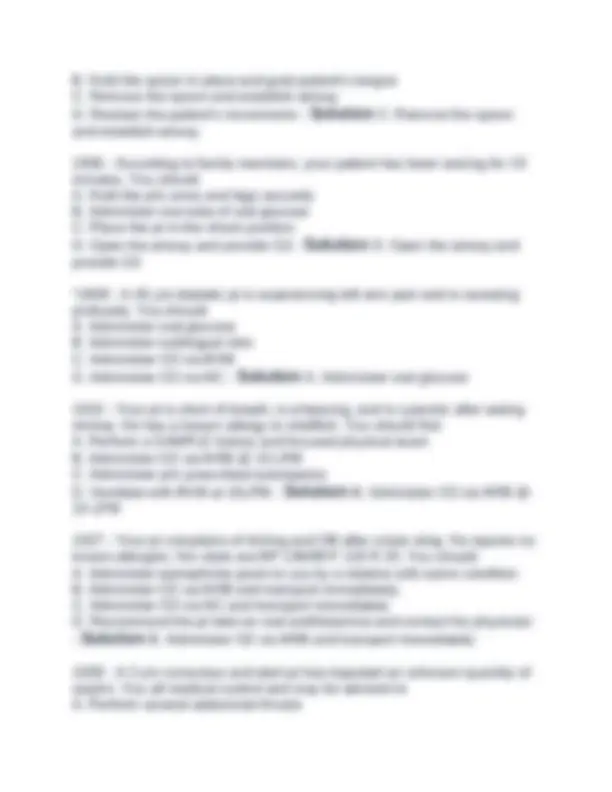
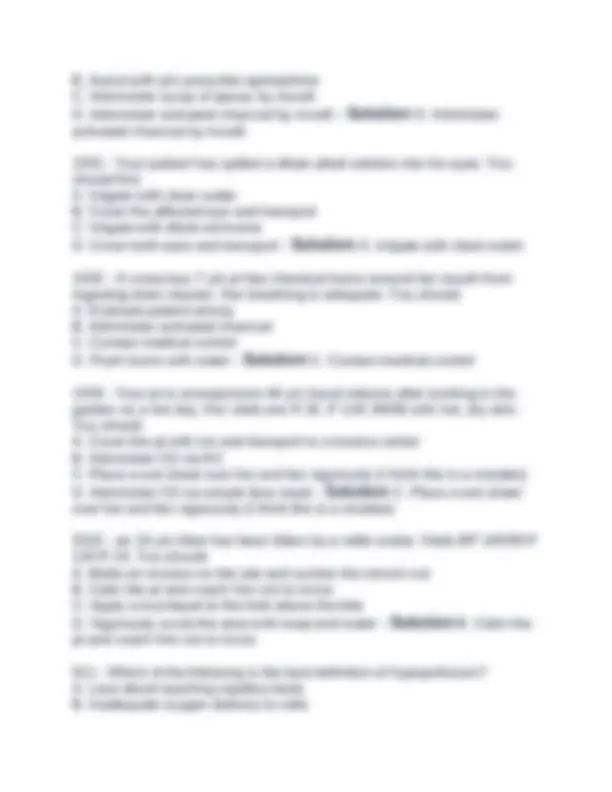
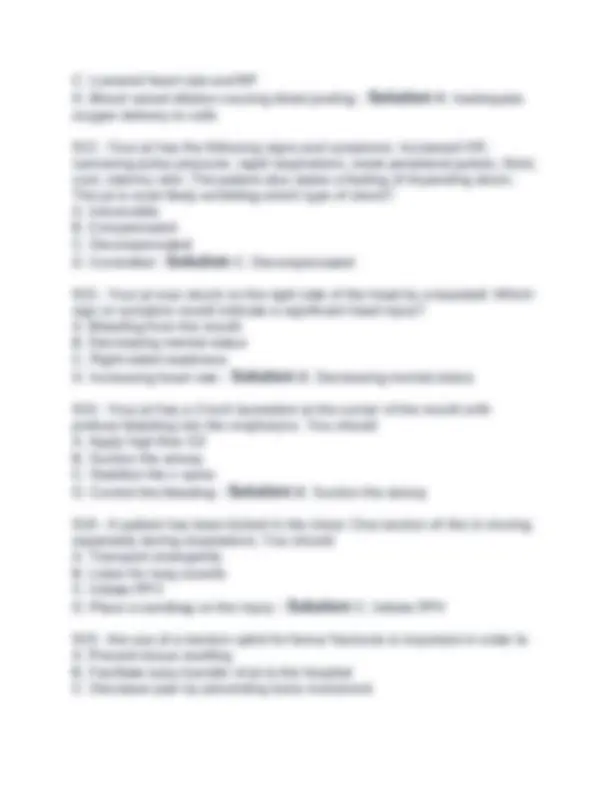
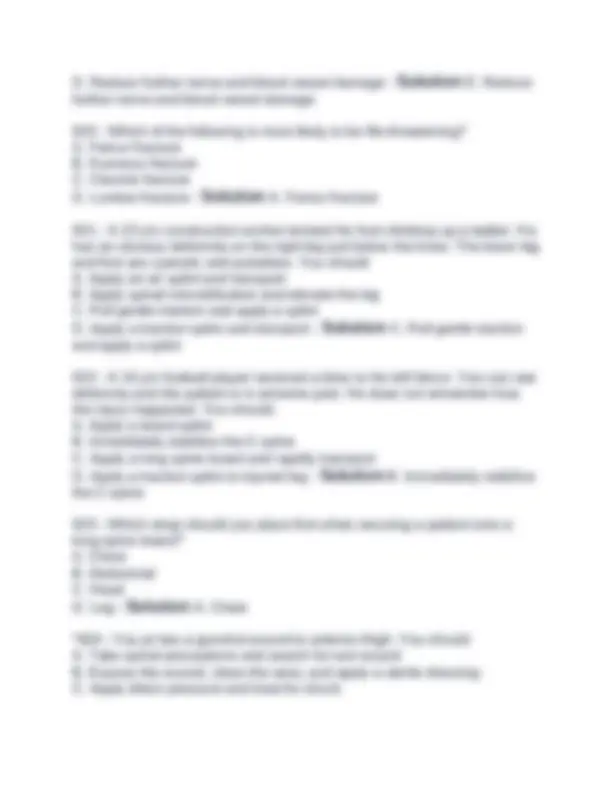
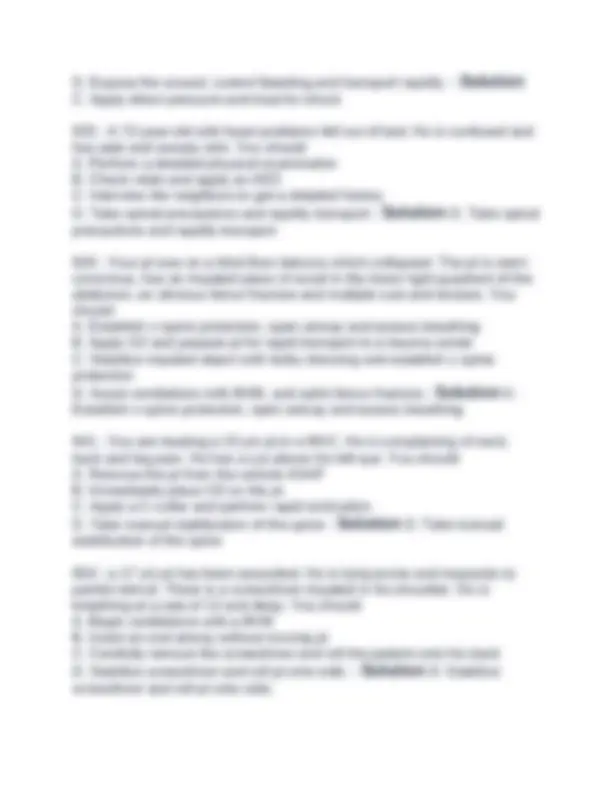
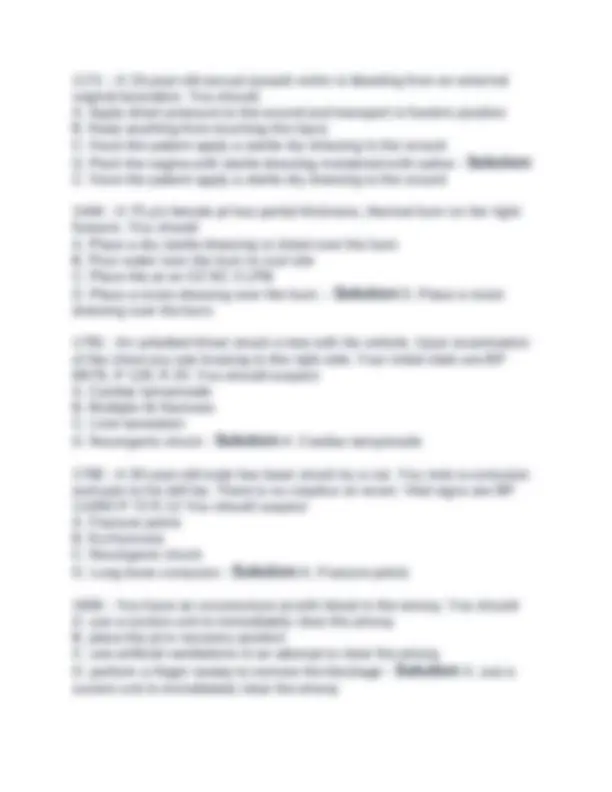
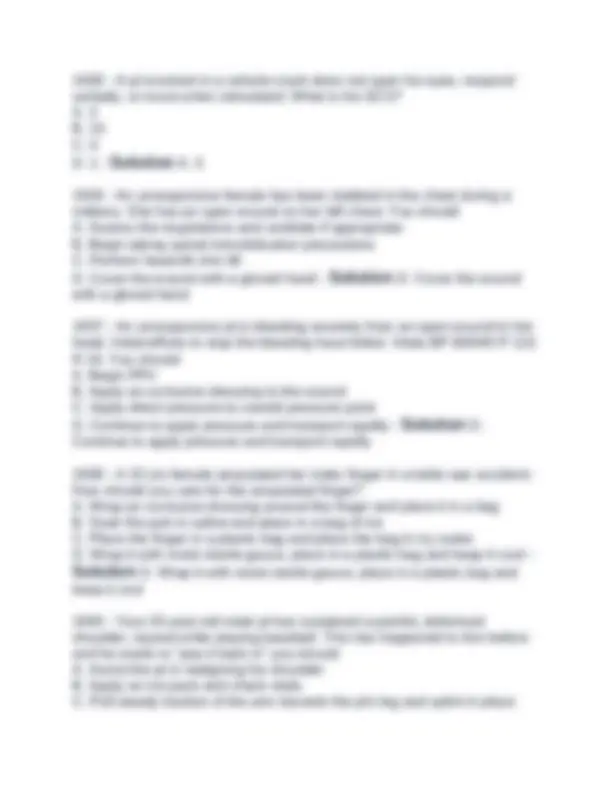
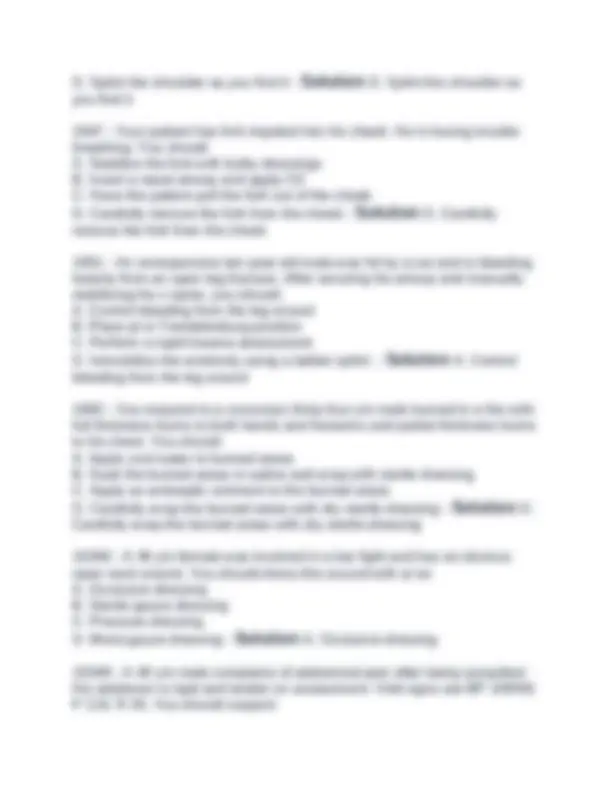
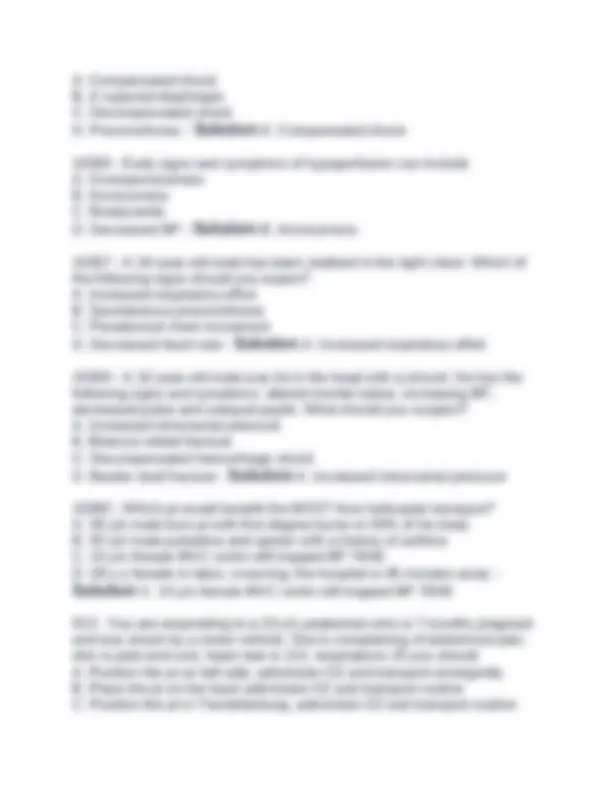
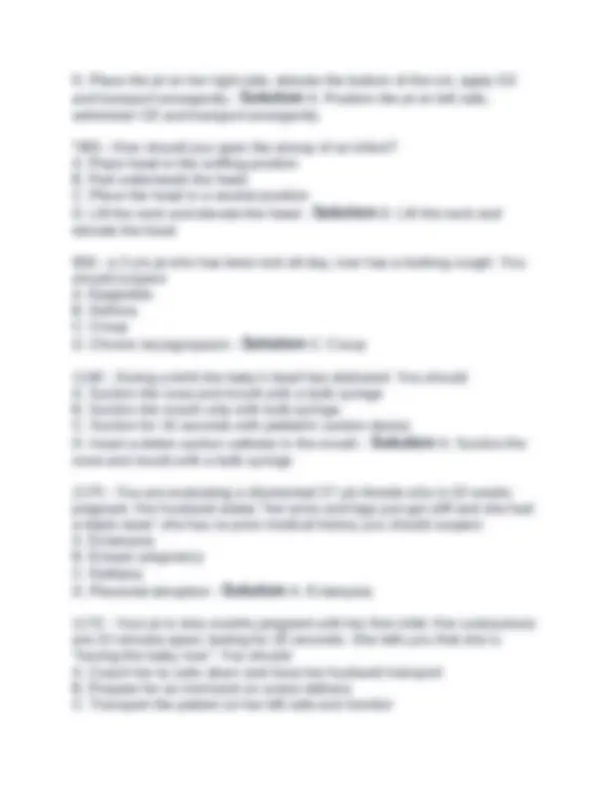
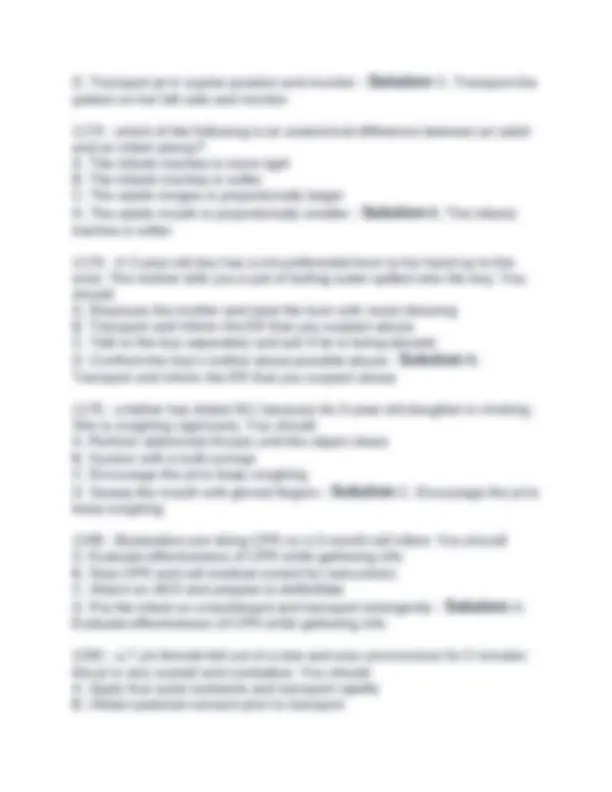
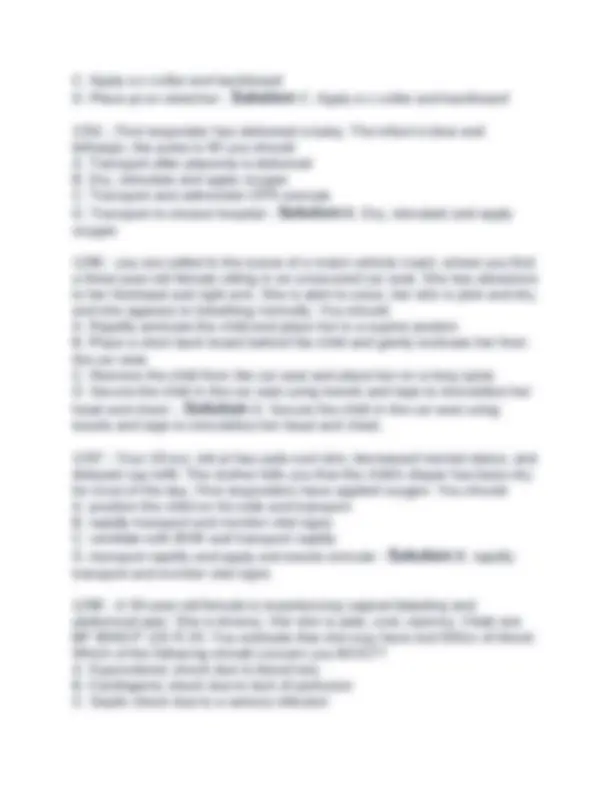
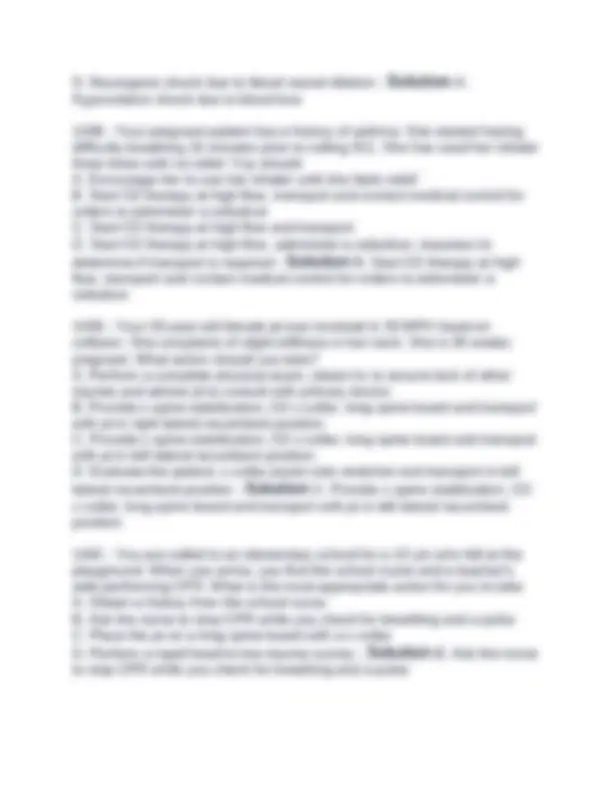
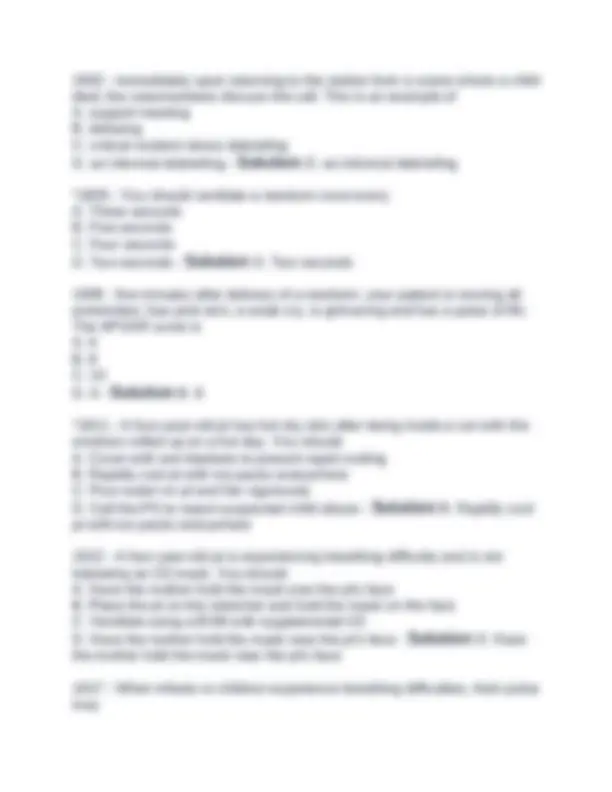
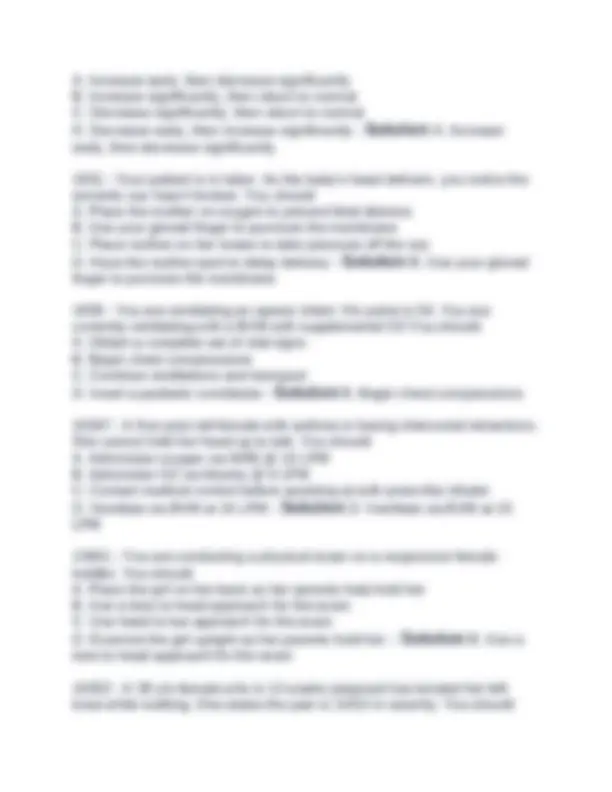
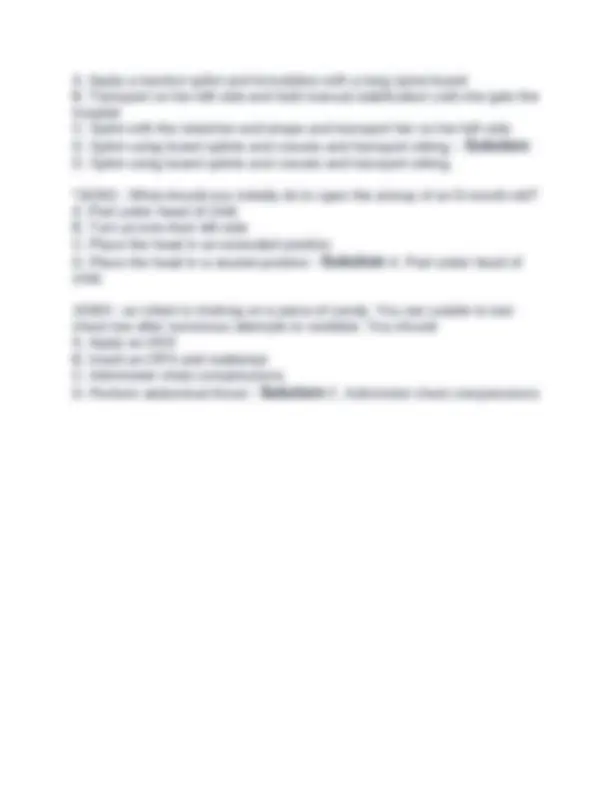


Study with the several resources on Docsity

Earn points by helping other students or get them with a premium plan


Prepare for your exams
Study with the several resources on Docsity

Earn points to download
Earn points by helping other students or get them with a premium plan
Community
Ask the community for help and clear up your study doubts
Discover the best universities in your country according to Docsity users
Free resources
Download our free guides on studying techniques, anxiety management strategies, and thesis advice from Docsity tutors
A collection of multiple-choice questions and answers related to cardiac emergencies, commonly encountered in emt exams. It covers topics such as cardiac arrhythmias, chest pain, cardiac arrest, and the use of nitroglycerin. The questions are designed to test the knowledge and understanding of emts in recognizing and managing cardiac emergencies.
Typology: Exams
1 / 35

This page cannot be seen from the preview
Don't miss anything!




























1155 - a malfunction of the heart's electrical system may result in A. Atherosclerosis B. Pericarditis C. Aneurysm
1156 - All of the following are indications for the use of nitro EXCEPT A. Patient has a history of cardiac problems B. The patient's physician has prescribed nitro C. Pt complains of CP
less than 90 *1157 - A 60 y/o female has chest pain. She has not taken her prescribed nitro you should A> Determine what type of cardiac problem the pt has, and assist her with taking the nitro B> Immediately attached the AED and begin transport to hospital C> Administer aspirin only and withhold the nitro D> Consult medical direction with regard to assisting the pt in taking the
and assist her with taking the nitro 1268 - You have assisted a 56 y/o pt in taking 1 nitro he continues to complain of CP. Vital signs are: BP 94/64, P 120, R 14, SaO2 98%. You should A. Reassess his BP B. Assist him with a 2nd nitro C. Transport
C. Transport 1269 - You are transporting a pt with CP, when suddenly she becomes unresponsive you should A. Start CPR and transport more rapidly B. Stop the ambulance and confirm absence of pulse
C. Immediately apply an AED and analyze
and confirm absence of pulse 1271 - __________________ is a cardiac arrhythmia characterized by a complete disorganization of electrical activity A. Ventricular tachycardia B. Pulseless electrical activity C. Ventricular fibrillation
1273 - One of the most problematic side effects of nitro is A. Hypotension B. Bradycardia C. Angina
1278 - The strongest portion of the heart that is responsible for circulating blood to the entire body is the A. Left atrium B. Right atrium C. Left ventricle
1279 - You are dispatched to a 68 y/o female complaining of discomfort in her upper back. She is nauseous and appears to be sweaty. Based on these symptoms, which of the possible causes is most life-threatening. A. Stroke B. Diabetic reaction C. Cardiac compromise
1281 - A 62 y/o female who has been drinking alcoholic beverages is feeling dizzy. She cannot walk and she complains of severe headache. You should suspect A. Delirium tremens B. Severe migraine C. Hemorrhagic stroke
*1287 - Your pt is a 56 y/o male who collapses while mowing the lawn. He is apneic and pulseless immediately following collapse. What is the patient most likely experiencing? A. Heart attack B. Cardiac Arrest C. Angina
1288 - A 62 y/o female is complaining of crushing CP that radiates to between her shoulder blades. She is very pale, diaphoretic, and feels nauseous. You should suspect a/an A. Cardiac event B. Cerebrovascular event C. Hypoglycemic reactions
1440 - A 67 y/o female just had a syncopal episode while using the toilet. Vitals are BP 100/6-. P 110 irregular, R 12. She is weak and dizzy. You should suspect a A. gastrointestinal obstruction B. vertebral vascular accident C. cardiac rhythm disturbance
1763 - A pulseless and apneic 68 y/o male has an implanted pacemaker in his right shoulder. Without delaying defibrillation where should you apply the AED pads. A. Left shoulder (to avoid pacemaker) and right lower chest B. Nipple line under the left and right armpits C. Anterior chest and back (between shoulder blades) D. Right shoulder (directly over the pacemaker) and lower left chest. -
1764 - A pt becomes unresponsive. You find she is apneic and pulseless. You should A. Start CPR and apply the AED B. Apply O2 via BVM and apply the AED
C. Apply AED and analyze
1816 - Albuterol is an example of a (an) A. Vasodilator B. Vasoconstrictor C. Antihypertensive
*1818 - Your 55-year-old pt complains of CP radiating to left arm. You should first A. Complete a SAMPLE history B. Administer prescribed nitro C. Place the pt on O
history 1826 - After delivering a shock with an AED, the patient begins to move and speak. You should A. Assess vitals and begin transport B. Immediately remove the AED to avoid accidental shock C. Begin BVM ventilations
begin transport *1827 - A 56 y/o male is complaining of severe CP. He took Viagra two hours ago and has been physically active. You should A. Assist the pt in taking his nitro and apply O B. Administer O2 and request an ALS intercept C. Monitor vitals, if BP is above 100 systolic, administer nitro and apply oxygen
Assure an open airway and continue gathering history 1829 - You have administered six shocks to your cardiac arrest patient. She remains pulseless and is not breathing. You should next A. Deliver two more shocks B. Continue your assessment
1935 - Your pt has been submerged underwater for an unknown period and is in cardiac arrest. After taking c-spine precautions you should A. Dry the pt off B. Ventilate the pt C. Apply pressure to abdomen
2118 - Your patient is pale, diaphoretic, and complains of chest pressure. Her vitals are R 18 P 58, and BP 88/50. You should suspect A. Unstable angina B. A thoracic aneurysm C. Cardiogenic shock
16345 - An 18 y/o male has become increasingly shaky several minutes after administration of a prescribed bronchodilator. You should A. assist the pt with another dose of the medication B. contact medical control to report the pt's response C. document the pt's response to the medication
the pt's response to the medication *16353 - A alert and oriented male is complaining of severe CP, but he refuses transportation against medical advice. You should A. Accept his right to refuse care and leave the scene B. Ask family to help convince him to be transported C. Contact law enforcement for assistance
help convince him to be transported 16354 - A pt with chest discomfort becomes unresponsive during transport to hospital. What is the most appropriate action? A. Start CPR while you assess for pulselessness and apnea, then apply AED and shock if necessary B. Confirm pulselessness, apnea, apply AED, and advise partner to drive vehicle emergently C. Conform pulselessness, initiate CPR, stop vehicle and apply AED
D. Stop vehicle, confirm pulselessness and apnea, apply AED, and shock if
apply AED, and shock if necessary 16355 - A 84-year-old female is anxious and complaining of SOB. She has been a smoke for most of her life. Upon examination, you find she has pedal edema. She is coughing up pink frothy sputum. You should suspect A. Complication of emphysema B. Congestive heart failure C. Chronic bronchitis
*893 - The first step an ambulance crew should take when approaching the scene of an emergency is to A. Verify number of patients B. Note the MOI C. Determine the scene is safe
894 - To protect yourself from injury when lifting a stretcher, you should A. Use two additional people for the lift B. Wear an orthopedic back brace C. Keep the weight close to your body
to your body 896 - You are completing a pt care report for a pt injured in a car crash. You notice the smell of alcohol and empty beer cans in the vehicle. The best way to document your findings in the PCR is to A. Discount these findings because your patient may not have been the driver B. Describe the smell of alcohol and empty beer cans which were noted at the scene C. Omit any reference to alcohol because you are not certain if the patient was drinking
Describe the smell of alcohol and empty beer cans which were noted at the scene
B. Developing regular exercise habits C. Drinking alcoholic beverages
exercise habits 939 - you are at the scene of a MVC which of the following situations would require rapid extrication? A. Your patient complains of arm tingling B. Your pt blocks access to critical pt C. There are multiple pt's at the scene
to critical pt 940 - You 90 y/o nursing home pt is pulseless and apneic. The nurse shows you a note in the patient's chart stating DNR. The note is signed by a physician. You should A. Call the pt's doctor and confirm order B. Consult with the family C. Call online medical control
medical control 942 - You are treating a 50 y/o male with CP. Your written protocol indicates that you should give nitro. This is known as A. License to practice B. An online medical directive C. Scope of practice
1252 - A 20 y/o female pt complains of severe abdominal pain. She is in the fetal position. After your primary assessment, you should A. Ask if she was assaulted B. Obtain baseline vitals C. Palpate all 4 quadrants of abdomen
1253 - A 45 y/o male farmer has been working with dry lime. The pt has large amounts of powder on both legs. You should A. Use milk to dilute and cocoon pt
B. Gently brush off excess powder and transport C. Wash of the powder with water and transport
excess powder and transport 1260 - You respond to a scene where a mentally ill adult is threatening to kill himself. He is refusing transportation to a hospital. You should A. Document the patient's refusal and have him sign your form B. Restrain the patient C. Ask law enforcement for assistance D. Allow a family member to transport the patient, if they promise to follow
1259 - You are transporting a patient who has been restrained due to hostile behavior. He is complaining that he has no feeling in his hands, and is threatening to sue you if you don't remove the restrains. He has been very cooperative since the restrains were placed. You should A. Place padding between the restraint and the pt's skin B. Assess the pt's distal circulation frequently C. Remove the restraints
frequently 1261 - A 24 y/o female has been stabbed and police state she is deceased. You note blood all over her clothing. You should A. Get permission from the police to move the pt B. Assess the airway and check for a pulse. C. Remove her clothing and determine the extent of the wounds
check for a pulse. 1262 - a 11 y/o male has crashed his bicycle. The patients baby sitter is requesting to know the extent of his injuries. You should reply A. "you will have to wait and talk with his parents" B. "his leg appears to be broken, do you have a phone number for his parents" C. "please discuss this matter with the police when they arrive"
1274 - When driving the ambulance, operators must drive with the safety of others in mind. This is known as driving A. With due regard B. Defensively C. With privileges
1276 - What are the recommended dimensions of a landing zone for air medical A. 75x B. 50x C. 200x
1277 - When responding to an incident involving an unidentified hazardous material, the most appropriate place to position the ambulance is A. Downwind and uphill from the incident B. Upwind and at the level of the incident C. Downwind and downhill from the incident
from the incident 1289 - you respond to a car accident on a busy city street. You are the first emergency vehicle on scene. Which of the following best describes where you should position your ambulance when arriving on scene? A. Park downhill or downwind from the wreckage so you can smell any hazards B. Park in front of the wreckage to warn oncoming motorist C. Park immediately in front of the wreckage so you have quick access to emergency supplies D. Park beyond the wreckage to protect your truck from being struck by
motorist 1336 - you are transporting a 68 y/o female from a nursing home to hospital. She has a valid DNR. During transportation, she begins to have trouble breathing. You should A. Ventilate the pt with a BVM B. Return the pt to nursing home
C. Provide supportive reassurance only
Provide oxygen and position the patient for comfort 1859 - Which of the following is an essential component of you oral report? A. The name of the pt personal physician B. The pt's social security number C. The EMT assessment of chief complaint
assessment of chief complaint 1929 - Your twelve-year-old pt has a penetrating wound to the abdomen. You may provide care based on A. Informed consent B. Mutual consent C. Implied consent
16358 - What is the most effective way to control the spread of infectious disease? A. Avoid contact with all bodily fluids B. Exercise good hand washing technique C. Wear a face shield on all calls
washing technique 957 - A patient is in respiratory distress after eating soup brought by her neighbor. Her neighbor states "she was eating and suddenly her throat got tight" she is sitting bolt upright in a tripod position. You should suspect A. Anaphylaxis B. Choking C. Emphysema
1148 - You are helping a 21 y/o pt to self-administer her epinephrine via auto-injector. She has been stung by a bee. You should A. Hold injector in place at least 10 seconds B. Immediately inject and release C. Inject it into the antecubital fossa
calmly to him and convince him to accept transport 1257 - An 18 y/o soccer player is feeling disoriented. He has been playing soccer in 90-degree heat. You should A. Direct the pt to drink at least 8 ox of orange juice B. Remove the pt's clothes and pour ice water on him C. Move the pt somewhere cool and assess vitals
Move the pt somewhere cool and assess vitals 1258 - An intoxicated 33 y/o female was fighting with police. You note some minor scrapes on the pt's leg and face. The pt is being verbally abusive to you. The police want your approval to take the pt to jail. You should A. Ask the officer to transport her to the hospital in a squad car for safety B. Request that the officers arrest the patient prior to transport C. If vital signs are within normal limits, release the pt to the police
and transport the pt with police escort 1291 - Your unresponsive pt is slumped over the kitchen table. A friend tells you that she was fine one minute and started acting abnormally the next. She moans in response to painful stimuli and her skin is pale, cool, and clammy. Her medical alert bracelet denotes diabetes. You should suspect A. Hypoglycemia B. Hyperglycemia C. Stroke
1292 - Of the following communicable diseases, which one is MOST likely to be transmitted through airborne droplets A. Salmonella B. HIV/AIDS C. Hepatitis
1293 - A the local homeless shelter, a 50 y/o male complains of fever. He is drowsy, weak and is coughing up blood. He states that he has had this persistent cough and fever for the past two days. You should suspect A. HIV/AIDS B. Hepatitis C. Tuberculosis
1294 - Which of the following symptoms would indicate a significant localized cold injury? A. Skin appears blue and is diaphoretic B. Tissue below the surface is soft C. Mottled or blotchy skin
hard 1295 - You are called to a local beach for a 10 y/o possible drowning pt. The pt's parents have pulled him from the water and he is sitting on a blanket coughing up small amounts of water. The parents state they do not want him to go to the hospital and thinks he only swallowed a small amount of water. His vitals are BP 100/50 P 72 R 20. What should you do? A. Ignore the parents' concerns, load the patient, and rapidly transport o the nearest emergency department B. Agree with the parents, because your assessment indicates that the child is fine C. Explain the complications of near drowning and the necessity of transport via ambulance D. Request that the parents transport the victim to the nearest emergency
1442 - Which of the following best describes a bipolar pt? A. They do not generally function normally in society B. They do not have a history of manic-depressive disorder C. They appear psychotic during manic phases
during manic phases 1443 - Which of the following pt is MOST at risk for hypovolemic shock? A. A hemophilia pt with a nosebleed
B. Administer O2 via NRB C. Flush pt's body with large amount of water
clothing 1824 - A seventeen y/o pt has ingested sleeping pills and alcohol. They are responsive only to painful stimuli. Vitals are BP 100/60, P 58, R 8. You should A. Administered activated charcoal B. Contact the parents for consent to transport C. Place in recovery position
1835 - you respond to a 22 y/o male with altered mental status. His skin is warm and diaphoretic and has a known seizure history. It is likely your pt is A. Postictal B. Clonic C. Hypovolemic
1852 - A diabetic patient was reported missing last evening. He is found unresponsive, lying in a ditch along the road in approximately two inches of water. Vital signs are BP 96/40, P 38, R 6. You should A. Place heat packs on pt's groin, neck and armpits B. Place glucose between the patients cheek and gum. C. Place the pt in Trendelenburg position
patient in blankets and transport. 1904 - Your pt is unresponsive and is wearing a medic alert bracelet stating he is a diabetic. You should A. Establish and maintain an airway B. Check for a regular carotid pulse C. Administer one tube of oral glucose
1905 - A patient is experiencing seizure activity and a bystander has placed a spoon in the patient's mouth to help control the airway. You should A. Tape the spoon in place to protect airway
B. Hold the spoon in place and grab patient's tongue C. Remove the spoon and establish airway
and establish airway 1906 - According to family members, your patient has been seizing for 10 minutes, You should A. Hold the pt's arms and legs securely B. Administer one tube of oral glucose C. Place the pt in the shock position
provide O *1908 - A 45 y/o diabetic pt is experiencing left arm pain and is sweating profusely. You should A. Administer oral glucose B. Administer sublingual nitro C. Administer O2 via BVM
1910 - Your pt is short of breath, is wheezing, and is cyanotic after eating shrimp. He has a known allergy to shellfish. You should first A. Perform a SAMPLE history and focused physical exam B. Administer O2 via NRB @ 15 LPM C. Administer pt's prescribed autoinjector
1927 - Your pt complains of itching and DB after a bee sting. He reports no known allergies. His vitals are BP 136/88 P 118 R 20. You should A. Administer epinephrine given to you by a relative with same condition B. Administer O2 via NRB and transport immediately. C. Administer O2 via NC and transport immediately D. Recommend the pt take an oral antihistamine and contact his physician